By: Dom Harvey
Recently I’ve been exploring various ideas for new Cubes, and as part of that I wanted to rethink the assumptions we often make about each colour to see what interesting options are available. In a lot of Cubes, Red is probably the colour with the least variety: you can make a R/X aggro deck, you can sprinkle a few burn spells in your control deck, and – if your Cube supports it (and not many do) – you can once in a while draft the Wildfire ramp deck. Meanwhile, every other colour has both more things and more interesting things going on; only white really has the same problem, but it still manages to exhibit greater diversity. I wanted to try revamping red by pushing a bunch of themes and staying true to the design philosophy of prioritizing interesting cards/game states over cards which are powerful in a vacuum, without crippling the red aggro decks that help maintain that end of the spectrum in Cube. I don’t expect all of these changes to hold up, but hopefully some of these ideas will be useful.
My main objectives:
- Move away from ‘mindless’ aggro decks by including cards that enable aggro-control or aggro-combo.
- Let red play a bigger role in control and combo decks.
- Find – and if needed/possible, double up on – cards that bridge multiple archetypes and/or colours.
So:
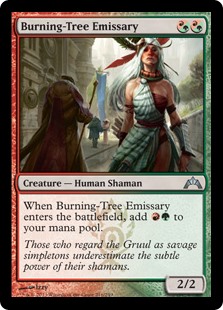
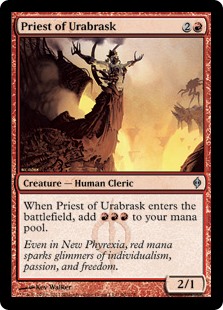
My first move was to triple up on a card that I’ve been drawn to ever since I first entertained the idea of duplication: Burning-Tree Emissary. It does everything I want to do with this project: it works in multiple archetypes (Storm, aggro) and colours (fits perfectly well in G/X aggro or midrange) while being a good card in its own right, and creates interesting decisions in design, draft, and gameplay. If you draft two of these, for instance, weaker cards that can be played off RG start to become more appealing than objectively stronger cards; and in-game, there’s often a tension between deploying your board as fast as possible as Emissary wants you to do and playing around sweepers/reserving spells for storm cards; and Emissary by itself is very weak, so there’s a trade-off between the fast starts it enables and its weakness later in the game. In design, you have to balance the distribution of 2-drops between those that can be cast of RG, those that can’t, and the Emissaries themselves. For a card that has such a damaging effect on Standard, it’s surprisingly interesting in Cube.

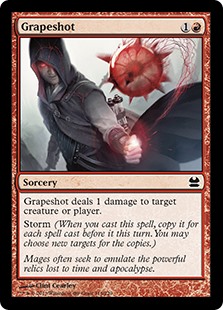
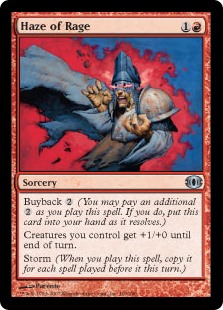
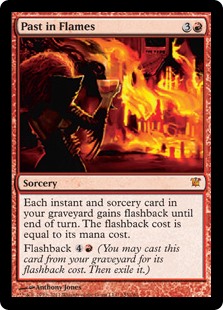

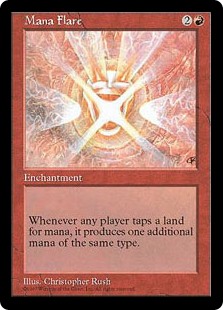
Storm is a controversial subtheme; even some of the people most open-minded about experimenting in Cube are reluctant to try Storm, on the grounds that it’s unreliable, doesn’t lead to interactive games, and requires loading up on cards that have no use outside of that one archetype (thereby also letting people go on auto-pilot in the draft). I think some of those concerns are unfounded, and in any case they can be addressed by approaching the topic carefully. Burning-Tree Emissary, for instance, is fantastic with both Storm Entity and Grapeshot, and there’s an interesting tension between it and Haze of Rage – do I play out all my guys to maximize the power spread, or do I hold some back to boost storm? The fact that these cards can be played in aggro decks stops them being narrow and makes those decks more complex. The best Storm card, however, is undoubtedly:
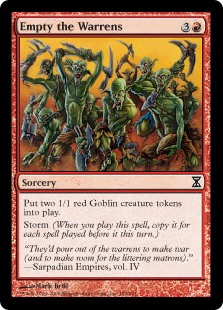
Empty the Warrens is good enough that I want multiple copies. Not only is it a good Storm finishes that nonetheless encourages interaction (a small or medium-sized Empty can be fended off by blockers, and there are enough sweepers to make it risky), but it’s also a nice curve-topper in an aggro-combo R/X deck. It also has a lot of incidental synergies and crossover with other archetypes. Consider a turn 4 of unsuspend Rift Bolt, Emissary, Empty; now consider it with a Carrion Feeder/Goblin Bombardment, cards that boost power (battle cry, Anthems) or anything that cares about having multiple creatures (battalion, Hellrider). It’s also rather nice with:
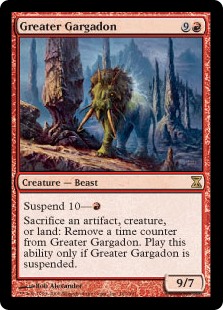
Greater Gargadon is another card that does a ton of things well without getting boring. It’s a 1-drop for the red aggro decks that isn’t a dumb animal like Jackal Pup or Goblin Patrol (the dynamic a Gargadon ticking down introduces to a game is fascinating, and from both sides no less), it’s a sac outlet for various shenanigans, it’s the perfect finisher for the Wildfire ramp decks and in concert with sweepers in general (to say nothing of Upheaval and Balance), it can get people out of nowhere, and the 10 CMC can be surprisingly relevant.
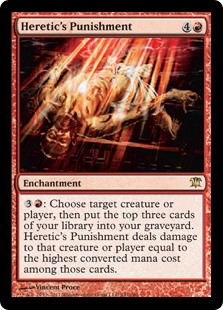
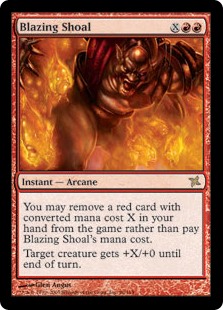
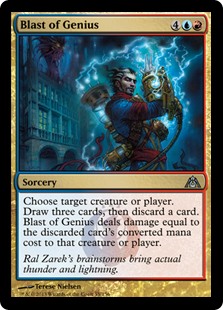

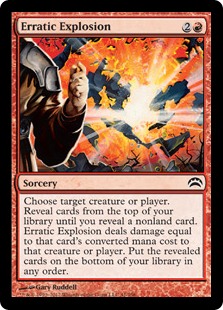
This is one of the more outlandish twists I want to try. It’s more shallow than some of the other subthemes I’m trying, but it slots nicely into place alongside them: the miracle/library manipulation subtheme (giving targets for these cards – e.g. Thunderous Wrath – and setting them up respectively), the Sneak Attack/Through the Breach/Show and Tell/Eureka/Flash/reanimator package that wants high-CMC fatties, cycling/evoke cards, Blasphemous Act (more on that soon) and so on. It creates some awesome games at little cost: even Blazing Shoal, the card with most blowout potential, forces decisions: showing it once puts the fear of God into the opponent in future games, making combat a nightmare, and the investment required to ‘go for it’ is substantial enough that it requires setup and good timing.
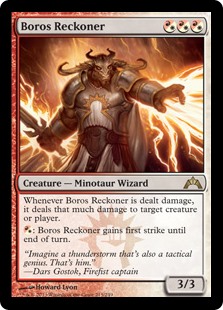
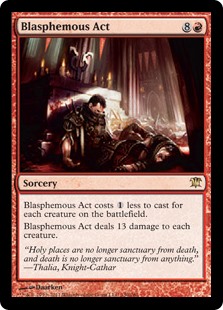
Boros Reckoner is exactly the type of card I’m looking for. It’s an excellent card in its own right, and it’s best against the type of decks that would want a Boros Reckoner, meaning that doubling or tripling up on it doesn’t make red aggro decks much more powerful at the expense of other strategies. In addition, the combos with the card are all nice against control decks as well, meaning that there are multiple dimensions to the card depending on how you want to use it. Its mana cost is one of the subtle things that makes the card so interesting: it rewards people for committing to red or white (or both) while being flexible enough to see play in other decks (in particular, the fact that it’s good at most stages of the game, especially if you’re using it to do silly things, means that it isn’t as much of a hindrance). The card is also just a ton of fun – it’s inexplicably satisfying to One-Hit KO your opponent by loading damage onto a Boros Reckoner.
Cards that combine well with Boros Reckoner include include Devastating Dreams, Sickening Dreams, Firestorm, Kindle the Carnage, Blasphemous Act, Chandra Nalaar, Spitebellows andRolling Earthquake.

The final red card I want in multiples is Faithless Looting. This is what ties all of these loose ends together. It’s unremarkable in the sense that everyone knows how good it is, but it performs a much-needed function and does it as efficiently as you could ask for. Having Looting gives you the freedom to take chances with some of the niche cards listed here, as you can dig for them when they’re wanted and cash them in when they aren’t.
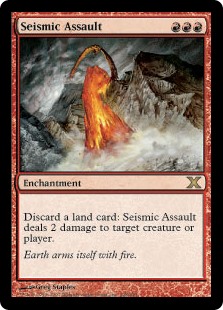
Lastly, Seismic Assault. I don’t need to go into how good it is with Life from the Loam, but it’s easy to overlook its interactions with cards like Land Tax, Meloku, the Clouded Mirror, Upheaval, Sunder and Memory Jar. By itself, it’s a recurring source of uncounterable, instant-speed damage that allows you to get value out of dead lands. Flame Jab is a neat card in the same vein that also helps build up a storm count.
Assorted Cards:
Flamekin Harbinger sets up Changeling Berserker/Titan, Vengevine, Avenger of Zendikar, Wolfbriar Elemental, Mulldrifter, Shriekmaw, Spitebellows, Mirror Entity, Reveillark and more.
Changeling Berserker fits into any tribal sub-theme you’re pushing, is great with 187 creatures, lets you tuck things away to insure against sweepers.
Devastating Summons is a cool top-end card that’s cheap enough to be incorporated into a storm chain and to set up a Summons-sweeper turn. The fact that it scales at will makes it very skill-intensive.
Chandra, the Firebrand gets a bad rap, but can be used to set up some truly sick plays.
This is just the tip of the iceberg. There’s an obvious tribal theme waiting to be explored in the form of Goblins, and less obvious ones like Elementals or Giants, and I’m sure there are many ideas I haven’t even considered yet. As I started tinkering with my Cube’s red section, one obvious problem arose: how can I properly support these themes without diluting the pool of cards necessary for red aggro or swelling the size of the Cube? To a degree this can be done by cutting some ‘redundant’ burn spells or some of the weaker creatures, but this will only go so far. There is a solution, however: give those cards to other colours!
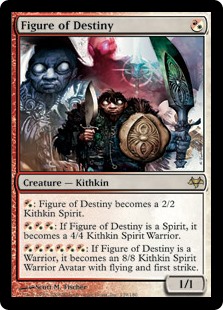
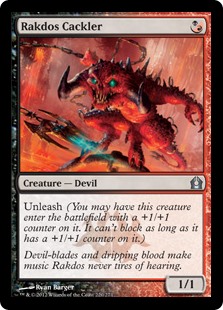

By doing this you improve not only aggressive decks in those other colours, but red aggro as well! The downsides of this approach also don’t apply as much to aggro: the problem, if you want to call it that, is that duplicating cards decreases variety, but aggressive creatures in Cube are largely interchangeable. Sure, you don’t want to switch out Grim Lavamancer for another vanilla 1-drop, but is your play experience really enhanced by having a Rakdos Cackler and a Jackal Pup instead of two Cacklers? The other worry is that the red section becomes bloated, taking up a disproportionate amount of space in the Cube. This is a legitimate concern, but it’s just as relevant for ordinary colour organization: we should adhere to colour balance in Cube construction not for its own sake, but because we think that it’s likely to ensure that all colours are draftable and no one colour dominates.
This may be an intuitive method of grouping cards, but it doesn’t acknowledge basic principles of deck construction. Are Carnophage and Griselbrand ever likely to be in your deck together? Not if your deck has a prayer of winning a match. A Swamp that just cast a Carnophage is about as likely to cast Griselbrand as it is to cast the 12th-pick Qasali Pridemage in your sideboard. How does it make sense to treat the two as the same in an important way when building your Cube? If very different red cards are each being put to their own ends in a wide range of decks, the fact that they have the same mana symbol in the corner is irrelevant. This is a larger topic best saved for another time, but I think it’s worth mentioning now so that we can consider these ideas free from ingrained prejudices.
I hope some of these ideas prove useful for you; even if you don’t end up adopting any of them for your own Cubes, the main take-away from this is that there is a lot of largely unexplored design space to play around in, both for red and in general. Thanks for reading!
Discuss this article in our forums.
![[IMG]](http://media.wizards.com/images/magic/tcg/products/cmd13/OW0TIk0s5j_EN.jpg)
![[IMG]](http://media.wizards.com/images/magic/tcg/products/cmd13/7HBiwtL2j7_EN.jpg)
![[IMG]](http://media.wizards.com/images/magic/tcg/products/cmd13/2JSuSisxfd_EN.jpg)
![[IMG]](http://media.wizards.com/images/magic/tcg/products/cmd13/dTYASfL8WC_EN.jpg)
![[IMG]](http://media.wizards.com/images/magic/tcg/products/cmd13/Hz67j0FwBN_EN.jpg)
![[IMG]](http://media.wizards.com/images/magic/tcg/products/cmd13/uZ1R1e9IWX_EN.jpg)
![[IMG]](http://media.wizards.com/images/magic/tcg/products/cmd13/8fjYT8FQWO_EN.jpg)
